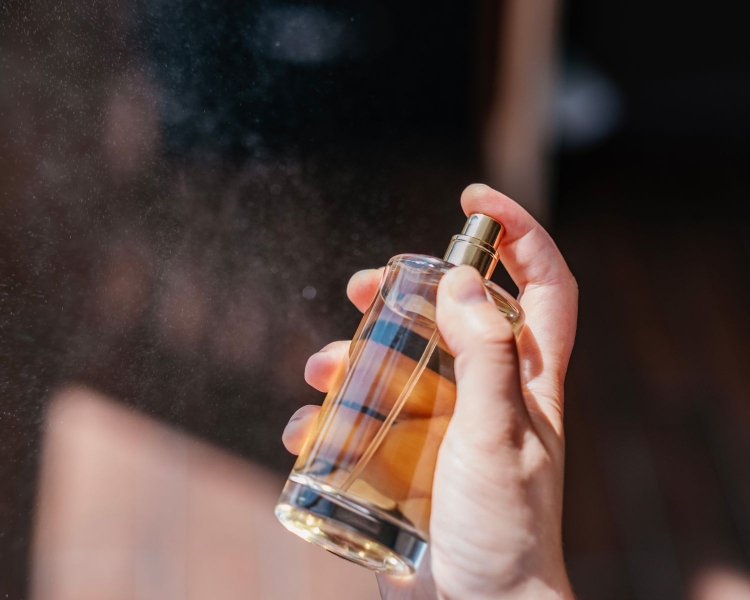Figure out what you like and where to find it.
Scent can be hard to describe. It can’t be transmuted through a computer screen, so we reach for abstract metaphors instead. Perfume ads depict diving into the Mediterranean, falling in love, or tearing off an evening gown. Product pages borrow from other senses, using words like milky, powdery, or sweet. We’re left with an idea of the feeling a scent is meant to evoke while the actual smell remains a mystery. But they’re not as nebulous as they may seem.
Each note in a given perfume can be categorized as one of nine core scents. These nine scents fall into four broader families: woody, amber, floral, and fresh. Few fragrances are just one thing—a perfume may have floral top notes offset by amber undertones, or notes of gourmand layered atop a woody base. Most perfumes fall into multiple categories, and what's floral on first spritz may dry down to something creamier or more earthy. But knowing each of the nine types of perfume scents can help you recognize themes in those you gravitate for, making the process of choosing one that much easier.
We break down each of the nine major scents below, so you can acquaint yourself with what you like and where to find it.
Woody
Woody scents smell how they sound, like fresh-cut wood or the forest after it rains. They evoke the feeling of sitting by a campfire or opening a leather-bound book. Sandalwood, cedarwood, vetiver, and patchouli feature often. Woody scents are rich and warm and often used as base notes, given their depth. They pair well with top notes that are light and floral. Examples of woody fragrances include Somebody Wood by Phlur, Santal 33 by Le Labo, and Baccarat Rouge 540.
Amber
Amber scents evoke warmth and spice—they can also be referred to as spicy. Historically they’ve been categorized as masculine, but they're now found in all kinds of fragrances. They may include warm tones like vanilla and patchouli, plus sharper notes of cinnamon, pepper, or cardamom, Lim says. Examples of amber fragrances include Avec Amour by Violette_FR, Glossier You, and Amber Musk by Aerin.
Gourmand
Gourmand emerged as a category more recently to describe the decadent, sweet scents that mimic walking into a bakery. Think elevated versions of the brown sugar body mists of the mid-2000s. Common notes include honey, vanilla, caramel, and coffee. Examples of gourmand fragrances include Brazilian Crush Cheirosa 62 by Sol de Janeiro, Joyphoria by Charlotte Tillbury, and Miami Nectar by Ellis Brooklyn.
Floral
From jasmine to rose, honeysuckle and lavender, floral scents may be the most famous in the world of perfume. They're soft, powdery, and smell like fresh bouquets. Balancing out a floral scent with something spicy or woody can lend depth and complexity. Examples of floral fragrances include Flower Head by Byredo, Neroli 36 by Le Labo, and Chanel Chance.

Fresh
Fresh scents are neutral and clean smelling, the no-makeup makeup of the perfume world. Bouge describes them as invigorating and reminiscent of ice and wild herbs. They tend to be subtler and have a shorter lifespan. Common notes include bergamot, citrus, and rain. Examples of fresh fragrances include Replica Lazy Sunday Morning by Mason Margella, Xtra Milk by DedCool, and Chloé Eau de Parfum.
Citrus
One of the more self-explanatory categories, citrus scents reference lemons, limes, oranges, and grapefruits, using essential oils sourced from the skin of these fruits. They're bright and fruity but not too sweet, evoking crisp morning air and sunny summer days. "Citrus scent is fresh, zesty, sunny, easy, dynamic," says perfumer Emilie Bouge, the nose behind Trudon's most recent citrus scent, Isla Eau de Parfum. Examples of citrus fragrances include Black Saffron by Byredo, Terre d‘Hermès, and Citrus Verbena Eau de Toilette by L'Occitane.
Fruity
While fruity may sound like a descriptor reserved for novelty lip balms, there are plenty of elevated iterations on the market. Like their namesakes, fruity scents are sweet and juicy. Compared to citrus scents, fruity ones are "sugary, velvety and less fresh," Bouge says. When balanced with more grounding notes, they don't have to be overpowering. Examples of fruity fragrances include English Pear and Freesia by Jo Malone, Mango Skin by Vilhelm Parfumerie, and Sun Fruit by Ellis Brooklyn.
Green
Green scents are grassy, bright, and fresh. “A green scent reminds me of walking through a lush, refreshing garden – it’s crisp, and often incorporates notes like vetiver or fig,” Lim says. Bouge points out that green scents can range from sweet to bitter, with sweet notes evoking youth, and bitter ones offering more distinction and elegance. Examples of green fragrances include Father Figure by Phlur, Debaser by D.S. & Durga, and Philosykos by Diptyque.
Aquatic
Lim describes aquatic scents as “fresh, clean, and crisp.” They’re watery and bright, like jumping into a pool or taking the first sip of a cool drink. A fruity-aquatic scent might reference melon, while a woody-aquatic scent might evoke sea-soaked driftwood. Examples of aquatic fragrances include Light Blue by Dolce & Gabbana and Acqua di Gio by Giorgio Armani.

